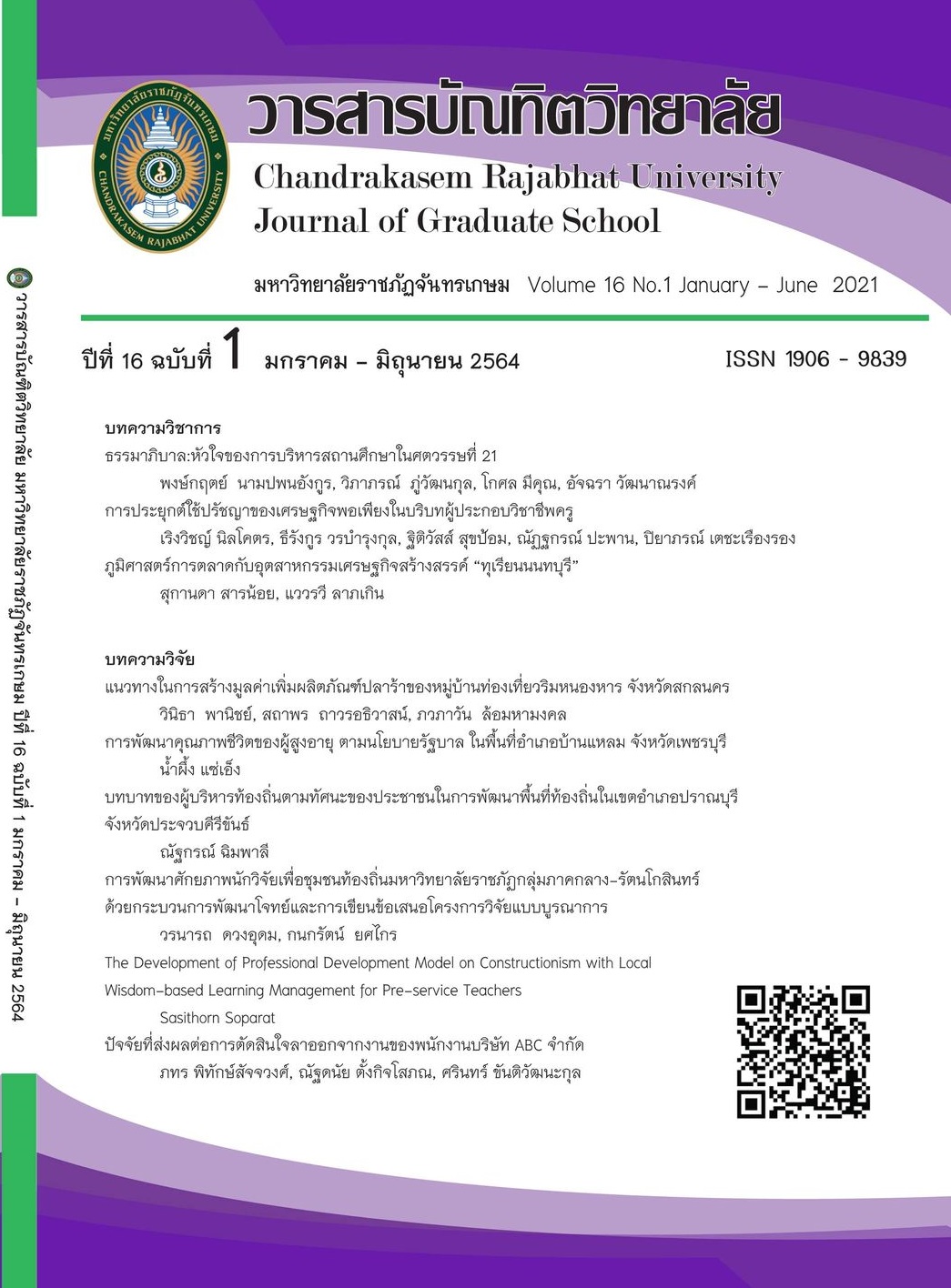ภูมิศาสตร์การตลาด กับอุตสาหกรรมเศรษฐกิจสร้างสรรค์ “ทุเรียนนนทบุรี”
Main Article Content
บทคัดย่อ
การศึกษาเรื่อง ภูมิศาสตร์การตลาด กับอุตสาหกรรมเศรษฐกิจสร้างสรรค์ “ทุเรียนนนทบุรี” ทำให้ทราบว่า ปัจจัยทางด้านภูมิศาสตร์มีผลต่อการพัฒนาศักยภาพด้านการผลิตสินค้าทางการเกษตรกรรมและสิ่งบ่งชี้ทางภูมิศาสตร์ ในการพัฒนาพื้นที่ เพื่อผลิตผลผลิตด้านการเกษตรของเกษตรกรทางด้านเศรษฐกิจและการส่งออกที่สำคัญอย่างหนึ่งของไทย รวมไปถึงการส่งขายภายในประเทศให้กับผู้บริโภค ทุเรียน เป็นผลไม้ที่มีหนามมีรูปร่างประเภทที่มีลักษณะพิเศษภายนอกซึ่งแสดงลักษณะของสายพันธุ์ที่แตกต่างกันไปทั้งพันธุ์พื้นเมืองดั้งเดิมและพันธุ์เศรษฐกิจในปัจจุบัน เนื้อของทุเรียนและกลิ่นเป็นเอกลักษณ์เฉพาะตัวที่ไม่มีผลไม้ใดเหมือน เกษตรกรชาวสวนทุเรียนจังหวัดนนทบุรีสร้างการตลาดจากการที่มีความเป็นอัตลักษณ์เฉพาะของการจำหน่ายทุเรียน โดยการนำเรื่องราวความเป็นตำนาน (story telling) ของพื้นที่การปลูกทุเรียนที่มีชื่อเสียงเป็นพื้นที่ที่ปลูกทุเรียนมีรสชาติดีและอร่อยซึ่งเป็นที่ยอมรับในระดับประเทศไทยและนานาชาติ และไม่มีการจำหน่ายทุเรียนนนทบุรีเป็นสินค้าส่งออกไปยังต่างประเทศ ด้วยสภาพทางภูมิศาสตร์ที่เหมาะสมต่อการเพาะปลูกเนื่องจากพื้นที่จังหวัดนนทบุรีอยู่ในตั้งอยู่ในบริเวณดินตะกอนที่มีความอุดมสมบูรณ์สูงจึงเป็นพื้นที่ที่สามารถสร้างความพิเศษและพร้อมจะสร้างสรรค์ทุนทางสังคมให้เกษตรกรชาวสวนได้ การผลิตของเกษตรกรชาวสวนทุเรียนไม่เน้นปริมาณจำนวนมากต่อฤดูกาลเพาะปลูก ดูแลตั้งแต่ช่วงผลผลิตออก จนกระทั่งเก็บเกี่ยวทุเรียนด้วยความพิถีพิถัน โดยชาวสวนทุเรียนนนทบุรีมีความเชื่อและเปรียบทุเรียนเหมือนกับการดูแลลูกสาวที่ต้องได้รับการทะนุถนอมดูแลอย่างดี และให้ความสำคัญกับการส่งขายให้กับผู้บริโภค หากผลผลิตได้รับความเสียหายหรือบริโภคไม่ได้ทางชาวสวนยินดีที่จะรับประกันเปลี่ยนทุเรียนหรือคืนเงินให้กับผู้ซื้อ สิ่งเหล่านี้จึงเป็นความพิเศษที่เกิดขึ้นระหว่างผู้ผลิต กับผู้บริโภคอย่างเป็นกระบวนการ และได้รับการส่งเสริมในรูปแบบของอุตสาหกรรมเศรษฐกิจสร้างสรรค์ที่เกิดขึ้น กับทุเรียนนนทบุรี
Article Details

อนุญาตภายใต้เงื่อนไข Creative Commons Attribution-NonCommercial-NoDerivatives 4.0 International License.
เอกสารอ้างอิง
กรมส่งเสริมวัฒนธรรม. (2560). รุกขมรดกของแผ่นดินใต้ร่มพระบารมี. กรุงเทพฯ: กรมส่งเสริมวัฒนธรรม กระทรวงวัฒนธรรม กรุงเทพฯ.
กรมวิชาการเกษตร. (2558). สถานการณ์การตลาดและต้นทุนในการผลิตทุเรียน "เอกสารวิชาการทุเรียน" ศูนย์วิจัยพืชสวนจันทบุรี ในโครงการหนังสืออิเล็กทรอนิกส์ เฉลิมพระเกียรติพระบทสมเด็จพระเจ้าอยู่หัว. สืบค้นจาก http:rakbankerd.com/agriculture/page.php?id=6863&s=tblplant.
ข่าวเศรษฐกิจ. (2561). ทุเรียนไทย Effect เบื้องหลังปรากฏการณ์ “ทุเรียนไทย” นักการตลาดต้องรู้. สืบค้นจาก http:positioningmag.com/1167419.
ชยันต์ ตันติวัสดาการ. (2550X. “ตลาดกึ่งแข่งขันกึ่งผูกขาดและตลาดผู้ขายน้อยราย.”เศรษฐศาสตร์จุลภาค : ทฤษฎีและการประยุกต์ รายงาน วิชา EC 492 การตลาดสินค้าเกษตร : ราคา และนโยบาย เรื่อง “ทุเรียนนนท์ผลไม้ 1 สลึง”. กรุงเทพฯ: มหาวิทยาลัยธรรมศาสตร์
ทรงพล สมศรี. (2551). ทุเรียนไทยและการปรับปรุงพันธุ์ กรณีศึกษาพันธุ์จันทบุรี 1 จันทบุรี 2 จันทบุรี 3. กรุงเทพฯ: สำนักผู้เชี่ยวชาญกรมวิชาการเกษตร.
นันท์ชยา ชื่นวรสกุล. (2560). โศกนาฏกรรมทุเรียนไทย. สืบค้นจากhttps://www.thairath.co.th/content/934632.
ผู้จัดการออนไลน์. การตลาดทุเรียนไทย. สืบค้นจากhttp: www.manager.co.th.
พิริยะ ผลพิรุณ. (2556). “เศรษฐกิจสร้างสรรค์กับการพัฒนาประเทศไทย” วารสารเศรษฐศาสตร์ปริทรรศน์ สถาบันพัฒนศาสตร์, 7(1), 4-13.
มณฑิณี ยงวิกุล. เศรษฐกิจสร้างสรรค์. สืบค้นจาก http:www.creativethailand.org/admin/public/uploads/images/2561/09/file_pdf/MagazineFile_108.pdf.
วิริยะ สว่างโชติ. (2561). อุตสาหกรรมทางวัฒนธรรมกับเศรษฐกิจสร้างสรรค์. กรุงเทพฯ: ภาพพิมพ์.
แววรวี ลาภเกิน. (2556). แนวทางการอนุรักษ์ภูมิปัญญาของชาวสวนทุเรียนจังหวัดนนทบุรี (วิทยานิพนธ์ปริญญามหาบัณฑิต). กรุงเทพฯ: มหาวิทยาลัยศิลปากร.
ศิราภรณ์ ณ ถลาง. (2561). “เศรษฐกิจสร้างสรรค์กับทุนวัฒนธรรมสัมพันธ์กันอย่างไร” ประเทศไทยในความคิดของเมธีอาวุโส (เล่ม1). กรุงเทพฯ: ไอดี ออล ดิจิตอลพริ้นท์.
อดิสรณ์ ฉิมน้อย. 2558. เศรษฐกิจทุเรียนนนท์. สืบค้นจาก http:www.duriannon.com.


